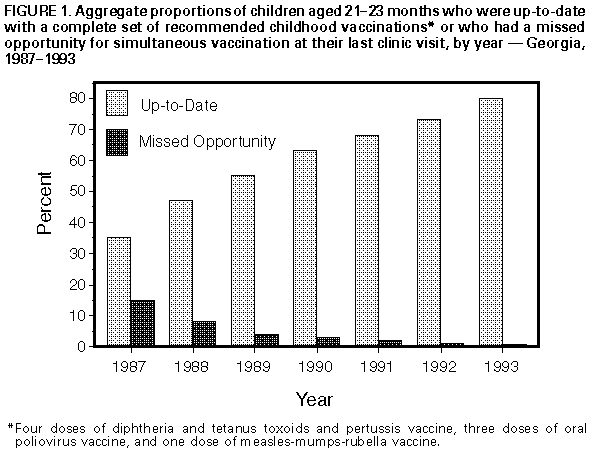 |
|
|
|
|
|
|
| ||||||||||
|
|
|
|
|
|
|
||||
| ||||||||||
|
|
|
|
|
Persons using assistive technology might not be able to fully access information in this file. For assistance, please send e-mail to: mmwrq@cdc.gov. Type 508 Accommodation and the title of the report in the subject line of e-mail. Evaluation of Vaccination Strategies in Public Clinics -- Georgia, 1985-1993From 1987 through 1993, the vaccination coverage levels among children served in public health clinics in Georgia more than doubled. This increase followed the implementation of a multifaceted strategy that included routine measurement of vaccination coverage levels. This report describes this program and an analysis of increases in vaccination coverage during 1985-1993. In 1985, the Georgia Division of Public Health (GDPH) reviewed the vaccination records of selected public clinics to assess vaccination coverage levels for the recommended childhood vaccines in relation to the national goal of 90% up-to-date by age 2 years. The results indicated that less than 40% of 2-year-olds served by the public sector had received a complete set of recommended vaccinations (i.e., four doses of diphtheria and tetanus toxoids and pertussis vaccine, three doses of oral poliovirus vaccine, and one dose of measles-mumps-rubella vaccine). In response, GDPH initiated a statewide annual assessment of vaccination coverage levels in public clinics. Information from these assessments assists in a program with four elements: 1) assessment of coverage levels and missed opportunity rates through analysis of birth and vaccination dates obtained for a sample of children from each clinic; 2) feedback of these data to the clinics; 3) issuance of awards (e.g., plaques) to health districts and clinics meeting coverage goals; and 4) dissemination of maps of coverage, rank-order lists, and other information to health district offices and public clinics. During 1987-1989, participation in the program increased from zero to include all of the approximately 220 public clinics and all 19 health districts in the state; these clinics provide vaccinations to approximately 70% of the state's birth cohort. Among children attending these clinics, the proportion who were up-to-date increased from 35% in 1987 to 80% in 1993 Figure_1, while the rate of missed simultaneous vaccination opportunities at the last visit declined from 15% to less than 1%. In 1987, aggregate coverage rates were less than 50% in 11 of 12 participating districts; in comparison, in 1993, aggregate rates were greater than or equal to 50% in all 19 districts, greater than 75% in 16, and greater than 90% in three. Reported by: M Chaney, Georgia Div of Public Health. National Immunization Program, CDC. Editorial NoteEditorial Note: National health objectives for the year 2000 include the goal that at least 90% of children should have completed the basic vaccination series by age 24 months (objective 20.11) (1). However, based on the National Health Interview Survey, in 1993, only 67% of 2-year-olds were up-to-date (2). Although national coverage levels have increased since 1991, intensified efforts are needed to improve provider practices and to encourage parents to ensure their children are vaccinated on schedule. The findings in this report suggest that institution of the multifaceted program in Georgia was associated with increased vaccination coverage. Preliminary findings from other states (e.g., Colorado and South Carolina) employing similar programs are consistent with findings in Georgia and indicate increases in coverage levels (CDC, unpublished data, 1995). Assessment of vaccination coverage levels of both public and private providers is specified in the Standards for Pediatric Immunization Practices (3), and federal funding is provided to each state and local grant program to support assessments in the public and private sectors. States receiving vaccination grant funds during 1995 are required to assess all public health clinics annually. * To assist with these assessments, Clinic Assessment Software Application (4) is available at no charge to public and private providers from the National Immunization Program, CDC, telephone (404) 639-8392. Efforts are in progress to adapt the assessment methodology to assist private providers in self-assessment. To ensure up-to-date vaccination for children, a high priority is the development and widespread use in the private sector of programs that have been associated in Georgia and other states with increases in vaccination coverage. References
* Public Law 103-333. Figure_1  Return to top. Disclaimer All MMWR HTML versions of articles are electronic conversions from ASCII text into HTML. This conversion may have resulted in character translation or format errors in the HTML version. Users should not rely on this HTML document, but are referred to the electronic PDF version and/or the original MMWR paper copy for the official text, figures, and tables. An original paper copy of this issue can be obtained from the Superintendent of Documents, U.S. Government Printing Office (GPO), Washington, DC 20402-9371; telephone: (202) 512-1800. Contact GPO for current prices. **Questions or messages regarding errors in formatting should be addressed to mmwrq@cdc.gov.Page converted: 09/19/98 |
|||||||||
This page last reviewed 5/2/01
|